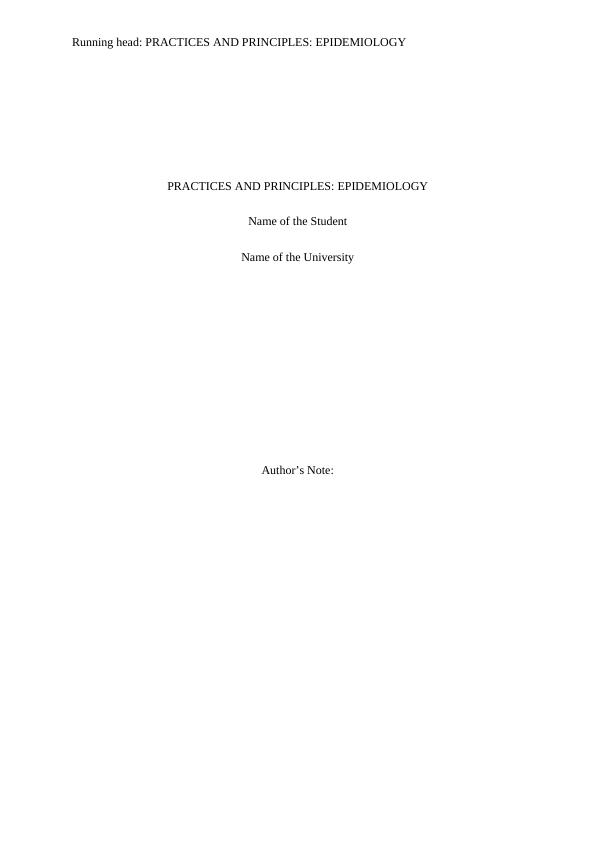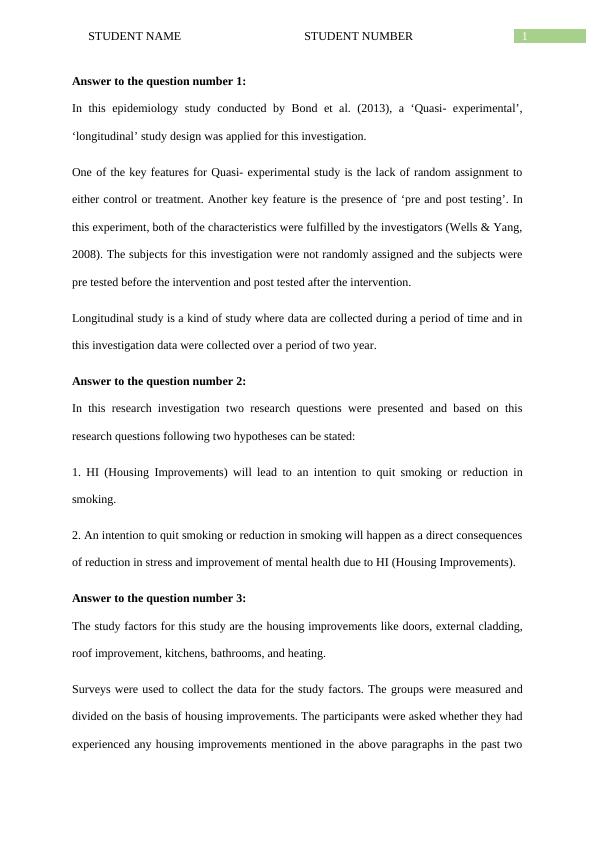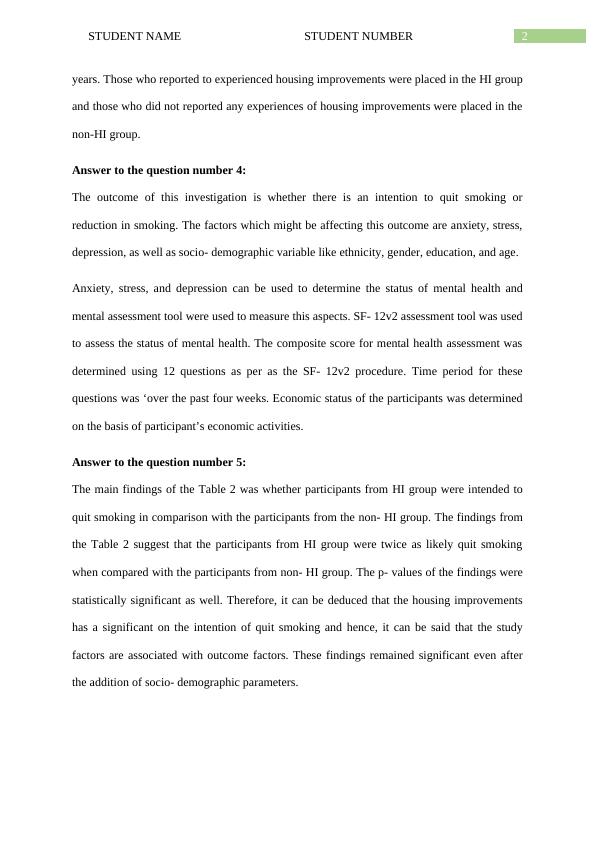Practices and Principles: Epidemiology
Added on 2023-04-20
8 Pages2264 Words91 Views
Running head: PRACTICES AND PRINCIPLES: EPIDEMIOLOGY
PRACTICES AND PRINCIPLES: EPIDEMIOLOGY
Name of the Student
Name of the University
Author’s Note:
PRACTICES AND PRINCIPLES: EPIDEMIOLOGY
Name of the Student
Name of the University
Author’s Note:

1STUDENT NAME STUDENT NUMBER
Answer to the question number 1:
In this epidemiology study conducted by Bond et al. (2013), a ‘Quasi- experimental’,
‘longitudinal’ study design was applied for this investigation.
One of the key features for Quasi- experimental study is the lack of random assignment to
either control or treatment. Another key feature is the presence of ‘pre and post testing’. In
this experiment, both of the characteristics were fulfilled by the investigators (Wells & Yang,
2008). The subjects for this investigation were not randomly assigned and the subjects were
pre tested before the intervention and post tested after the intervention.
Longitudinal study is a kind of study where data are collected during a period of time and in
this investigation data were collected over a period of two year.
Answer to the question number 2:
In this research investigation two research questions were presented and based on this
research questions following two hypotheses can be stated:
1. HI (Housing Improvements) will lead to an intention to quit smoking or reduction in
smoking.
2. An intention to quit smoking or reduction in smoking will happen as a direct consequences
of reduction in stress and improvement of mental health due to HI (Housing Improvements).
Answer to the question number 3:
The study factors for this study are the housing improvements like doors, external cladding,
roof improvement, kitchens, bathrooms, and heating.
Surveys were used to collect the data for the study factors. The groups were measured and
divided on the basis of housing improvements. The participants were asked whether they had
experienced any housing improvements mentioned in the above paragraphs in the past two
Answer to the question number 1:
In this epidemiology study conducted by Bond et al. (2013), a ‘Quasi- experimental’,
‘longitudinal’ study design was applied for this investigation.
One of the key features for Quasi- experimental study is the lack of random assignment to
either control or treatment. Another key feature is the presence of ‘pre and post testing’. In
this experiment, both of the characteristics were fulfilled by the investigators (Wells & Yang,
2008). The subjects for this investigation were not randomly assigned and the subjects were
pre tested before the intervention and post tested after the intervention.
Longitudinal study is a kind of study where data are collected during a period of time and in
this investigation data were collected over a period of two year.
Answer to the question number 2:
In this research investigation two research questions were presented and based on this
research questions following two hypotheses can be stated:
1. HI (Housing Improvements) will lead to an intention to quit smoking or reduction in
smoking.
2. An intention to quit smoking or reduction in smoking will happen as a direct consequences
of reduction in stress and improvement of mental health due to HI (Housing Improvements).
Answer to the question number 3:
The study factors for this study are the housing improvements like doors, external cladding,
roof improvement, kitchens, bathrooms, and heating.
Surveys were used to collect the data for the study factors. The groups were measured and
divided on the basis of housing improvements. The participants were asked whether they had
experienced any housing improvements mentioned in the above paragraphs in the past two

2STUDENT NAME STUDENT NUMBER
years. Those who reported to experienced housing improvements were placed in the HI group
and those who did not reported any experiences of housing improvements were placed in the
non-HI group.
Answer to the question number 4:
The outcome of this investigation is whether there is an intention to quit smoking or
reduction in smoking. The factors which might be affecting this outcome are anxiety, stress,
depression, as well as socio- demographic variable like ethnicity, gender, education, and age.
Anxiety, stress, and depression can be used to determine the status of mental health and
mental assessment tool were used to measure this aspects. SF- 12v2 assessment tool was used
to assess the status of mental health. The composite score for mental health assessment was
determined using 12 questions as per as the SF- 12v2 procedure. Time period for these
questions was ‘over the past four weeks. Economic status of the participants was determined
on the basis of participant’s economic activities.
Answer to the question number 5:
The main findings of the Table 2 was whether participants from HI group were intended to
quit smoking in comparison with the participants from the non- HI group. The findings from
the Table 2 suggest that the participants from HI group were twice as likely quit smoking
when compared with the participants from non- HI group. The p- values of the findings were
statistically significant as well. Therefore, it can be deduced that the housing improvements
has a significant on the intention of quit smoking and hence, it can be said that the study
factors are associated with outcome factors. These findings remained significant even after
the addition of socio- demographic parameters.
years. Those who reported to experienced housing improvements were placed in the HI group
and those who did not reported any experiences of housing improvements were placed in the
non-HI group.
Answer to the question number 4:
The outcome of this investigation is whether there is an intention to quit smoking or
reduction in smoking. The factors which might be affecting this outcome are anxiety, stress,
depression, as well as socio- demographic variable like ethnicity, gender, education, and age.
Anxiety, stress, and depression can be used to determine the status of mental health and
mental assessment tool were used to measure this aspects. SF- 12v2 assessment tool was used
to assess the status of mental health. The composite score for mental health assessment was
determined using 12 questions as per as the SF- 12v2 procedure. Time period for these
questions was ‘over the past four weeks. Economic status of the participants was determined
on the basis of participant’s economic activities.
Answer to the question number 5:
The main findings of the Table 2 was whether participants from HI group were intended to
quit smoking in comparison with the participants from the non- HI group. The findings from
the Table 2 suggest that the participants from HI group were twice as likely quit smoking
when compared with the participants from non- HI group. The p- values of the findings were
statistically significant as well. Therefore, it can be deduced that the housing improvements
has a significant on the intention of quit smoking and hence, it can be said that the study
factors are associated with outcome factors. These findings remained significant even after
the addition of socio- demographic parameters.

End of preview
Want to access all the pages? Upload your documents or become a member.
Related Documents
Critical Appraisal of a Paperlg...
|13
|3146
|394
Relationship between Housing Improvement and Desire to Stop Smokinglg...
|10
|3746
|247
Epidemiological Studies and Housing Improvementlg...
|8
|2635
|98
The Question and Answerslg...
|11
|3343
|15
Epidemiology: Risk Assessment, Generalisability, Feasibility and Limitationslg...
|6
|1362
|123
Strategic Research In International Marketslg...
|9
|2304
|205
